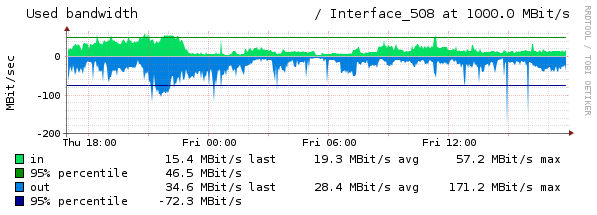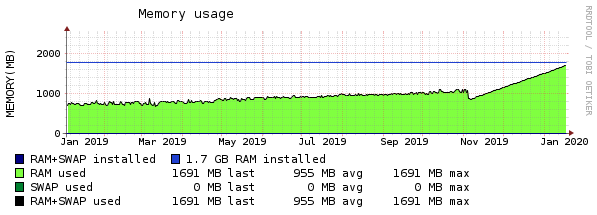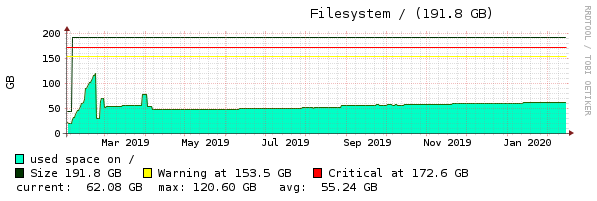|
|
Sponsored Content
Top Forums
UNIX for Advanced & Expert Users
Nearly Random, Uncorrelated Server Load Average Spikes
Post 303044127 by stomp on Friday 14th of February 2020 12:23:07 PM
|
|
10 More Discussions You Might Find Interesting
1. UNIX for Advanced & Expert Users
we have an unix system which has
load average normally about 20.
but while i am running a particular unix batch which performs heavy
operations on filesystem and database average load
reduces to 15.
how can we explain this situation?
while running that batch idle cpu time is about %60-65... (0 Replies)
Discussion started by: gfhgfnhhn
0 Replies
2. UNIX for Dummies Questions & Answers
Hello all, I have a question about load averages.
I've read the man pages for the uptime and w command for two or three different flavors of Unix (Red Hat, Tru64, Solaris). All of them agree that in the output of the 2 aforementioned commands, you are given the load average for the box, but... (3 Replies)
Discussion started by: Heathe_Kyle
3 Replies
3. UNIX for Dummies Questions & Answers
Hello, Here is the output of top command. My understanding here is,
the load average 0.03 in last 1 min, 0.02 is in last 5 min, 0.00 is in last 15 min.
By seeing this load average, When can we say that, the system load averge is too high?
When can we say that, load average is medium/low??... (8 Replies)
Discussion started by: govindts
8 Replies
4. Solaris
Hi,
i have installed solaris 10 on t-5120 sparc enterprise.
I am little surprised to see load average of 2 or around on this OS.
when checked with ps command following process is using highest CPU. looks like it is running for long time and does not want to stop, but I do not know... (5 Replies)
Discussion started by: upengan78
5 Replies
5. UNIX for Dummies Questions & Answers
Hello AlL,..
I want from experts to help me as my load average is increased and i dont know where is the problem !!
this is my top result :
root@a4s # top
top - 11:30:38 up 40 min, 1 user, load average: 3.06, 2.49, 4.66
Mem: 8168788k total, 2889596k used, 5279192k free, 47792k... (3 Replies)
Discussion started by: black-code
3 Replies
6. UNIX for Advanced & Expert Users
Hi ,
I am using 48 CPU sunOS server at my work.
The application has facility to check the current load average before starting a new process to control the load.
Right now it is configured as 48. So it does mean that each CPU can take maximum one proces and no processe is waiting.
... (2 Replies)
Discussion started by: kumaran_5555
2 Replies
7. Solaris
NPROC USERNAME SWAP RSS MEMORY TIME CPU
320 oracle 23G 22G 69% 582:55:11 85%
47 root 148M 101M 0.3% 99:29:40 0.3%
53 rafmsdb 38M 60M 0.2% 0:46:17 0.1%
1 smmsp 1296K 5440K 0.0% 0:00:08 0.0%
7 daemon ... (2 Replies)
Discussion started by: snjksh
2 Replies
8. UNIX for Dummies Questions & Answers
Hi,
I am getting a high load average, around 7, once an hour. It last for about 4 minutes and makes things fairly unusable for this time.
How do I find out what is using this. Looking at top the only thing running at the time is md5sum.
I have looked at the crontab and there is nothing... (10 Replies)
Discussion started by: sm9ai
10 Replies
9. UNIX for Dummies Questions & Answers
how load average is calculated and what exactly is it
difference between cpu% and load average (9 Replies)
Discussion started by: robo
9 Replies
10. Programming
Here we go....
Preface:
..... so in a galaxy far, far, far away from commercial, data sharing corporations.....
For this project, I used the ESP-WROOM-32 as an MQTT (publish / subscribe) client which receives Linux server "load averages" as messages published as MQTT pub/sub messages.... (6 Replies)
Discussion started by: Neo
6 Replies
LEARN ABOUT DEBIAN
html::lint
HTML::Lint(3pm) User Contributed Perl Documentation HTML::Lint(3pm) NAME
HTML::Lint - check for HTML errors in a string or file VERSION
Version 2.20 SYNOPSIS
my $lint = HTML::Lint->new; $lint->only_types( HTML::Lint::Error::STRUCTURE ); $lint->parse( $data ); $lint->parse_file( $filename ); my $error_count = $lint->errors; foreach my $error ( $lint->errors ) { print $error->as_string, " "; } HTML::Lint also comes with a wrapper program called weblint that handles linting from the command line: $ weblint http://www.cnn.com/ http://www.cnn.com/ (395:83) <IMG SRC="spacer.gif"> tag has no HEIGHT and WIDTH attributes. http://www.cnn.com/ (395:83) <IMG SRC="goofus.gif"> does not have ALT text defined http://www.cnn.com/ (396:217) Unknown element <nobr> http://www.cnn.com/ (396:241) </nobr> with no opening <nobr> http://www.cnn.com/ (842:7) target attribute in <a> is repeated And finally, you can also get Apache::HTML::Lint that passes any mod_perl-generated code through HTML::Lint and get it dumped into your Apache error_log. [Mon Jun 3 14:03:31 2002] [warn] /foo.pl (1:45) </p> with no opening <p> [Mon Jun 3 14:03:31 2002] [warn] /foo.pl (1:49) Unknown element <gronk> [Mon Jun 3 14:03:31 2002] [warn] /foo.pl (1:56) Unknown attribute "x" for tag <table> METHODS
NOTE: Some of these methods mirror HTML::Parser's methods, but HTML::Lint is not a subclass of HTML::Parser. new() Create an HTML::Lint object, which inherits from HTML::Parser. You may pass the types of errors you want to check for in the "only_types" parm. my $lint = HTML::Lint->new( only_types => HTML::Lint::Error::STRUCTURE ); If you want more than one, you must pass an arrayref: my $lint = HTML::Lint->new( only_types => [HTML::Lint::Error::STRUCTURE, HTML::Lint::Error::FLUFF] ); $lint->parser() Returns the parser object for this object, creating one if necessary. $lint->parse( $text ) $lint->parse( $code_ref ) Passes in a chunk of HTML to be linted, either as a piece of text, or a code reference. See HTML::Parser's "parse_file" method for details. $lint->parse_file( $file ) Analyzes HTML directly from a file. The $file argument can be a filename, an open file handle, or a reference to an open file handle. See HTML::Parser's "parse_file" method for details. $lint->eof Signals the end of a block of text getting passed in. This must be called to make sure that all parsing is complete before looking at errors. Any parameters (and there shouldn't be any) are passed through to HTML::Parser's eof() method. $lint->errors() In list context, "errors" returns all of the errors found in the parsed text. Each error is an object of the type HTML::Lint::Error. In scalar context, it returns the number of errors found. $lint->clear_errors() Clears the list of errors, in case you want to print and clear, print and clear. $lint->only_types( $type1[, $type2...] ) Specifies to only want errors of a certain type. $lint->only_types( HTML::Lint::Error::STRUCTURE ); Calling this without parameters makes the object return all possible errors. The error types are "STRUCTURE", "HELPER" and "FLUFF". See HTML::Lint::Error for details on these types. $lint->gripe( $errcode, [$key1=>$val1, ...] ) Adds an error message, in the form of an HTML::Lint::Error object, to the list of error messages for the current object. The file, line and column are automatically passed to the HTML::Lint::Error constructor, as well as whatever other key value pairs are passed. For example: $lint->gripe( 'attr-repeated', tag => $tag, attr => $attr ); Usually, the user of the object won't call this directly, but just in case, here you go. $lint->newfile( $filename ) Call "newfile()" whenever you switch to another file in a batch of linting. Otherwise, the object thinks everything is from the same file. Note that the list of errors is NOT cleared. Note that $filename does NOT need to match what's put into parse() or parse_file(). It can be a description, a URL, or whatever. MODIFYING HTML
::LINT'S BEHAVIOR Sometimes you'll have HTML that for some reason cannot conform to HTML::Lint's expectations. For those instances, you can use HTML comments to modify HTML::Lint's behavior. Say you have an image where for whatever reason you can't get dimensions for the image. This HTML snippet: <img src="logo.png" height="120" width="50" alt="Company logo"> <img src="that.png"> causes this error: foo.html (14:20) <img src="that.png"> tag has no HEIGHT and WIDTH attributes But if for some reason you can't get those dimensions when you build the page, you can at least stop HTML::Lint complaining about it. <img src="this.png" height="120" width="50" alt="Company logo"> <!-- html-lint elem-img-sizes-missing: off, elem-img-alt-missing: off --> <img src="that.png"> <!-- html-lint elem-img-sizes-missing: on, elem-img-alt-missing: off --> If you want to turn off all HTML::Lint warnings for a block of code, use <!-- html-lint all: off --> And turn them back on with <!-- html-lint all: off --> You don't have to use "on" and "off". For "on", you can use "true" or "1". For "off", you can use "0" or "false". For a list of possible errors and their codes, see HTML::Lint::Error, or run perldoc HTML::Lint::Error. BUGS, WISHES AND CORRESPONDENCE All bugs and requests are now being handled through GitHub. https://github.com/petdance/html-lint/issues DO NOT send bug reports to http://rt.cpan.org/ or http://code.google.com/ TODO
o Check for attributes that require values o <TABLE>s that have no rows. o Form fields that aren't in a FORM o Check for valid entities, and that they end with semicolons o DIVs with nothing in them. o HEIGHT= that have percents in them. o Check for goofy stuff like: <b><li></b><b>Hello Reader - Spanish Level 1 (K-3)</b> COPYRIGHT &; LICENSE Copyright 2005-2012 Andy Lester. This program is free software; you can redistribute it and/or modify it under the terms of the Artistic License v2.0. http://www.opensource.org/licenses/Artistic-2.0 Please note that these modules are not products of or supported by the employers of the various contributors to the code. AUTHOR
Andy Lester, andy at petdance.com perl v5.14.2 2012-04-06 HTML::Lint(3pm)



